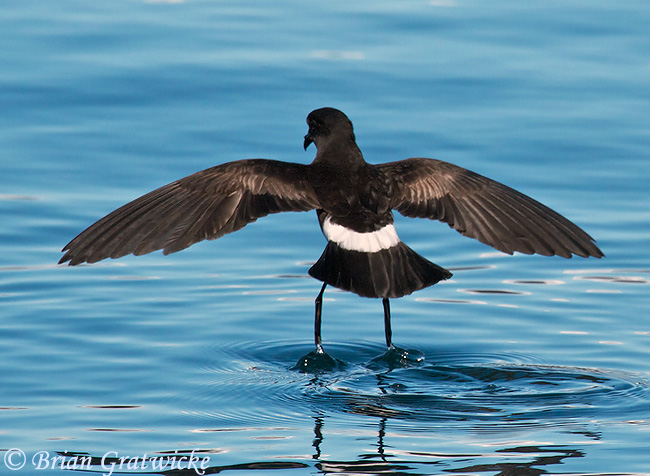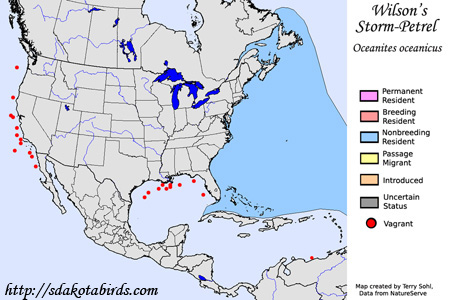| Length: 7.25 inches | Wingspan: 18 inches | Seasonality: Non-resident in South Dakota |
| ID Keys: Dark sooty-brown overall with obvious white rump patch, paler upper-wing coverts, dark legs, dark feet with yellow webbing | ||
 The
Wilson's Storm-Petrel is one of the most abundant birds in the North
Atlantic during the northern Hemisphere summer. However, they are very
long distance migrants in the region, as their breeding grounds are found on
Antarctica and some far southern islands near South America. Truly
pelagic in nature, the small birds are tougher than they appear, as outside
of the breeding season, they spend their entire lives on the open ocean.
They are only rarely sighted from land, and usually only when storm events
push the birds closer to shore.
The
Wilson's Storm-Petrel is one of the most abundant birds in the North
Atlantic during the northern Hemisphere summer. However, they are very
long distance migrants in the region, as their breeding grounds are found on
Antarctica and some far southern islands near South America. Truly
pelagic in nature, the small birds are tougher than they appear, as outside
of the breeding season, they spend their entire lives on the open ocean.
They are only rarely sighted from land, and usually only when storm events
push the birds closer to shore.
Habitat: Found in the open ocean from the freezing waters at the edges of the Arctic and Antarctic ice pack, to the warm waters of the tropics. They breed on the continent of Antarctica itself, as well as a number of island groups in the far southern oceans.
Diet: Feeds on small crustaceans and small fish, as well as marine worms, small squid, and carrion. They will follow fishing vessels for discarded fish material.
Behavior: Feeds in the manner of other Storm-Petrels, with a "foot-pattering" as they hover on the ocean's surface, pattering their feet on the water and grabbing food items with their bill. They will also sometimes forage by swimming on the ocean's surface and directly grabbing food items when spotted.
Nesting: The Wilson's Storm-Petrel breeds in colonies starting in November or December. The nest consists of a crevice or cavity in rocks, on a cliff, or in a burrow in the ground. Only one egg is laid, and both the male and female help to incubate it. Upon hatching, the young is tended to and fed by both parents.
Song: Usually silent at sea away from breeding colonies.
Migration: Very long-distance migrants, breeding in the far southern oceans, but with non-breeding birds migrating in very large numbers to the North Atlantic. Their status in the North Pacific is less known, but they have been increasingly found on pelagic birding tours that go far out from the coast of California.
Interactive eBird map: Click here to access an interactive eBird map of Wilson's Storm Petrel sightings
Similar Species: Similar to other dark, white-rumped Storm-Petrels found in North American waters (Band-rumped Storm-Petrel, Leach's Storm-Petrel, Wedge-rumped Storm-Petrel)
Conservation Status: Wilson's Storm-Petrels are one of the most abundant birds in the world's oceans, with a stable population and a widespread geographic range. The IUCN lists the Wilson's Storm-Petrel as a species of "Least Concern".
Further Information: 1) Wikipedia - Wilson's Storm Petrel
2) BirdLife International - Wilson's Storm-Petrel
3) Australia's Antarctic Program - Wilson's Storm-Petrel
Photo Information: Photo taken by Brian Gratwicke on May 14th, 2012 in the south Atlantic Ocean - Photo licensed under Creative Commons Attribution 2.0 Generic License
| Click below for a higher-resolution map |
 |
| South Dakota Status: Non-resident in South Dakota |
Additional Wilson's Storm-Petrel Photos (Coming soon!)
